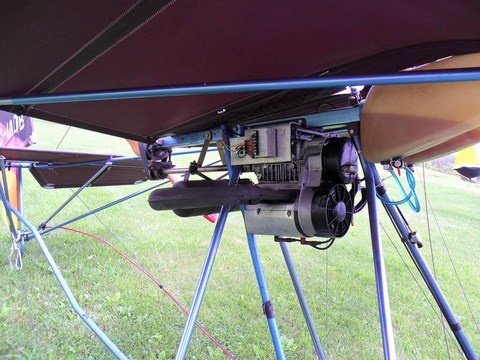Quicksilver MX airframe troubleshooting reports
The airframe on the Quicksilver MX was made up of aircraft grade anodized aluminums tubing and in most cases AN nuts and bolts. This made for a very reliable low maintenance combination.
That is it made a good combination if the pilot made perfect landings and take offs, directly into the wind from a smooth runway, which unfortunately was not always the case, especially in a training environment.
QUICKSILVER MX KING POST
One of the first problems encountered when abusing the MX was that of the KING POST CHANNEL BRACKETS FAILING, usually after a rough series of landings. In all reported
cases that I know of where this has happened the King Post remained upright, held by the gas tank and sail.
The point of failure was at the bend in the channel bracket. In early 1984 if memory serves me correct the manufacturer did update their brackets to a higher strength
because of this problem. Thus if you have an MX prior to 84, it is suggested you check this area, and update immediately.
Another reported problem was that of customers in the field over tightening the King Post. The proper way to tighten an MX King Post is to bring it up snug, by hand, DO NOT USE VISE©GRIPS OR A PIPE WRENCH. Some MX owners tried lubricating the threads on the king post, this resulted in the king post backing itself down during flight, causing loose flying wires and an improper angle of incidence to the tail, and in some cases a loss of proper elevator control.
Another problem encountered due to hard landings was the bending of the King Post. On some later model MX 11's the aluminums King Post was replaced by a chromoly KING POST.
QUICKSILVER MX WIRE TANGS AND NOSE WIRE FAILURE
Another problem area, located above the wing was in the tang used to connect the King Post upper nose wire to the front of the root tube. This tang was reported to crack at the bend. As well the bolt used to retain the upper and lower nose wires was reported to have broken.
To help eliminate this problem it was suggested that the tang on the lower nose wire be replaced with a double tang, with a larger bolt hole, which used two separate wires
for support, and that the upper tang be replaced with a stronger tang drilled out, to allow the use of a 5/16" bolt rather than the original 1/4"bolt.
QUICKSILVER MX ROOT TUBE FAILURE

The manufacturers recommendation was to replace the root tube on the MX 11 every 200 hours, and on most other models at 300 hours. (A complete maintenance schedule is available from any Quicksilver dealer, or parts centre).
The areas of most concern on the Quicksilver MX involved:
1. The area where the King post channel bracket fastens to the root tube. It was reported that the root tube was bending, or indenting immediately below the channel bracket.
This could be caused by over tightening the king post, or by numerous hard landings or a combination of the two.
2. The area where the leading and trailing edge channel brackets attach to the root tube. This area was reported to show signs of wear and cracking, as well as elongation of the holes.
In several cases in Canada it was reported on the MX 11 that the root tube had SPLIT FROM THE LEADING TO TRAILING EDGE BOLTS , on one side of the root tube. This must have happened during flight since a thorough preflight was done prior to the planes taking off.
Quicksilver MX Ultralight Aircraft Axle Failure
The main axle on the MX proved time and again to be very forgiving. In fact many pilots simply kept flying even when the main axle was bent.
This AXLE HAS BEEN REPORTED TO BREAK , at the bolt which connects the lower tail wires to the axle, and/or where rear down tubes connect to the channel bracket on the axle.
Several pilots have been in the process of taking off when the plane has simply collapsed around them.
This is not something that happens overnight but is rather caused by hard landings over a period of time. It is suggested that if your main axle is bent that you replace it. As well check the hole in the axle where the bolt holding the down tube bracket to the axle is, elongation of this hole has also been reported.
http://www.ultralightflyer.com - A Quicksilver MX three axis conversion kit, showing the conversion flying.



